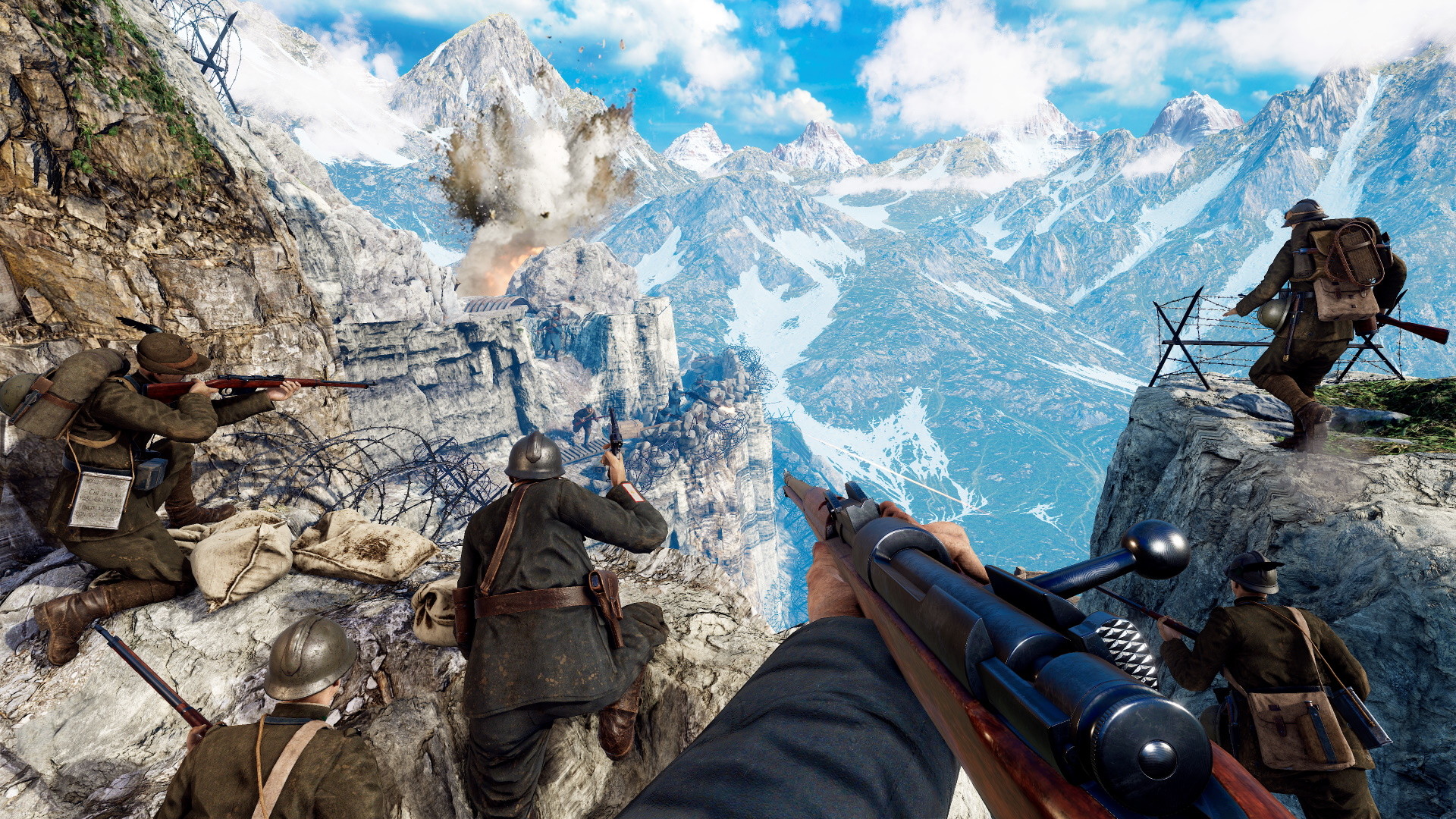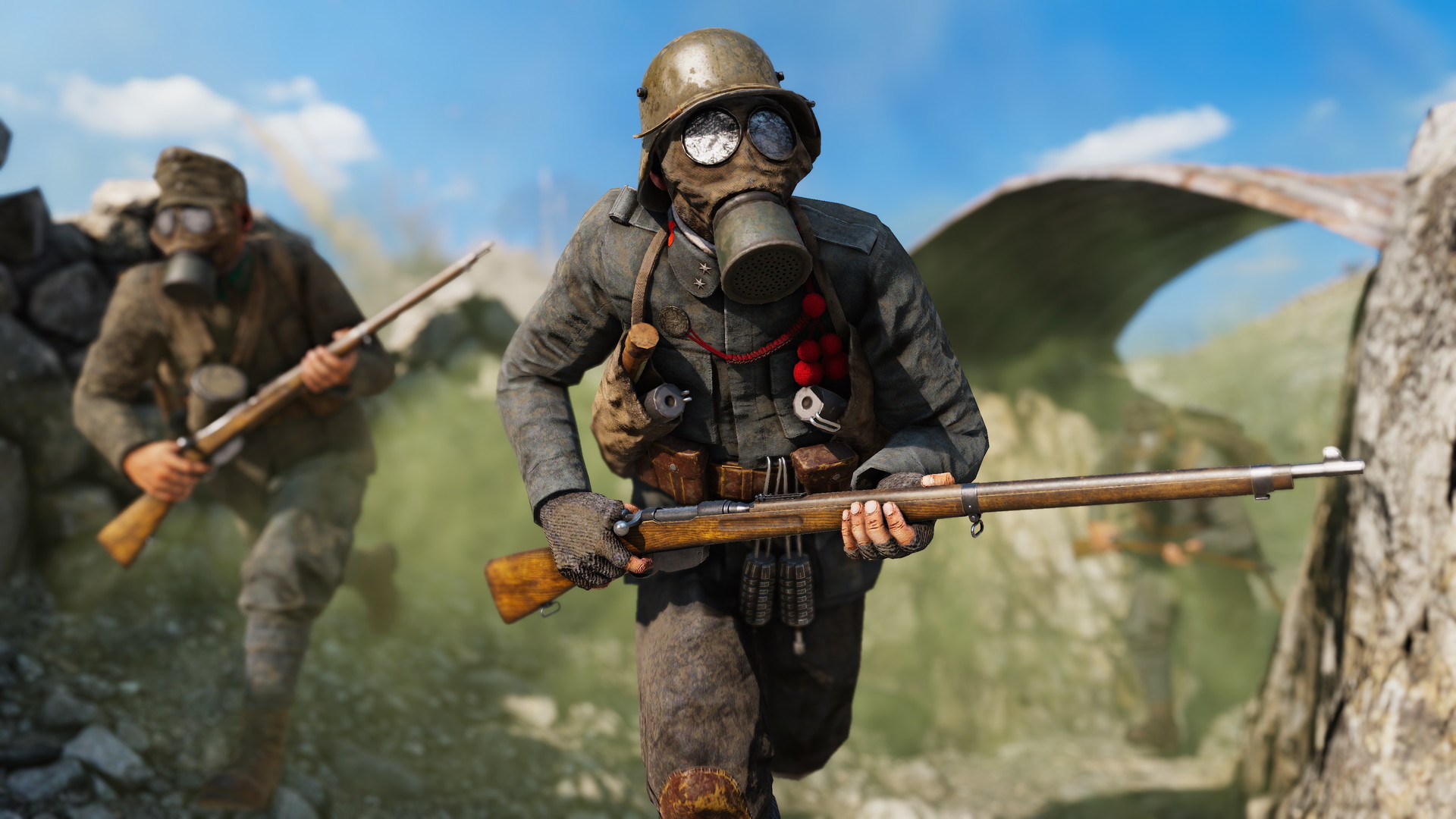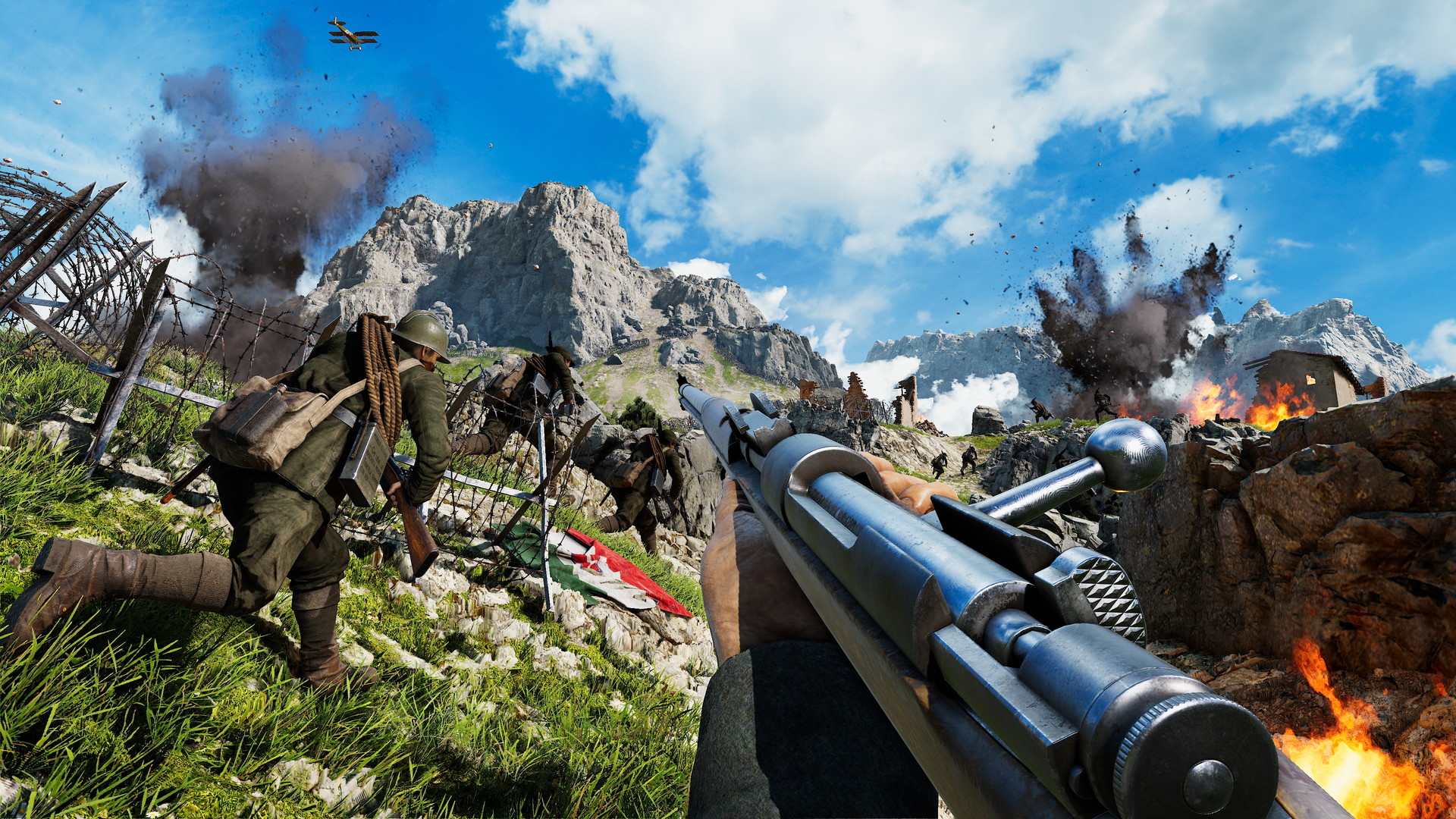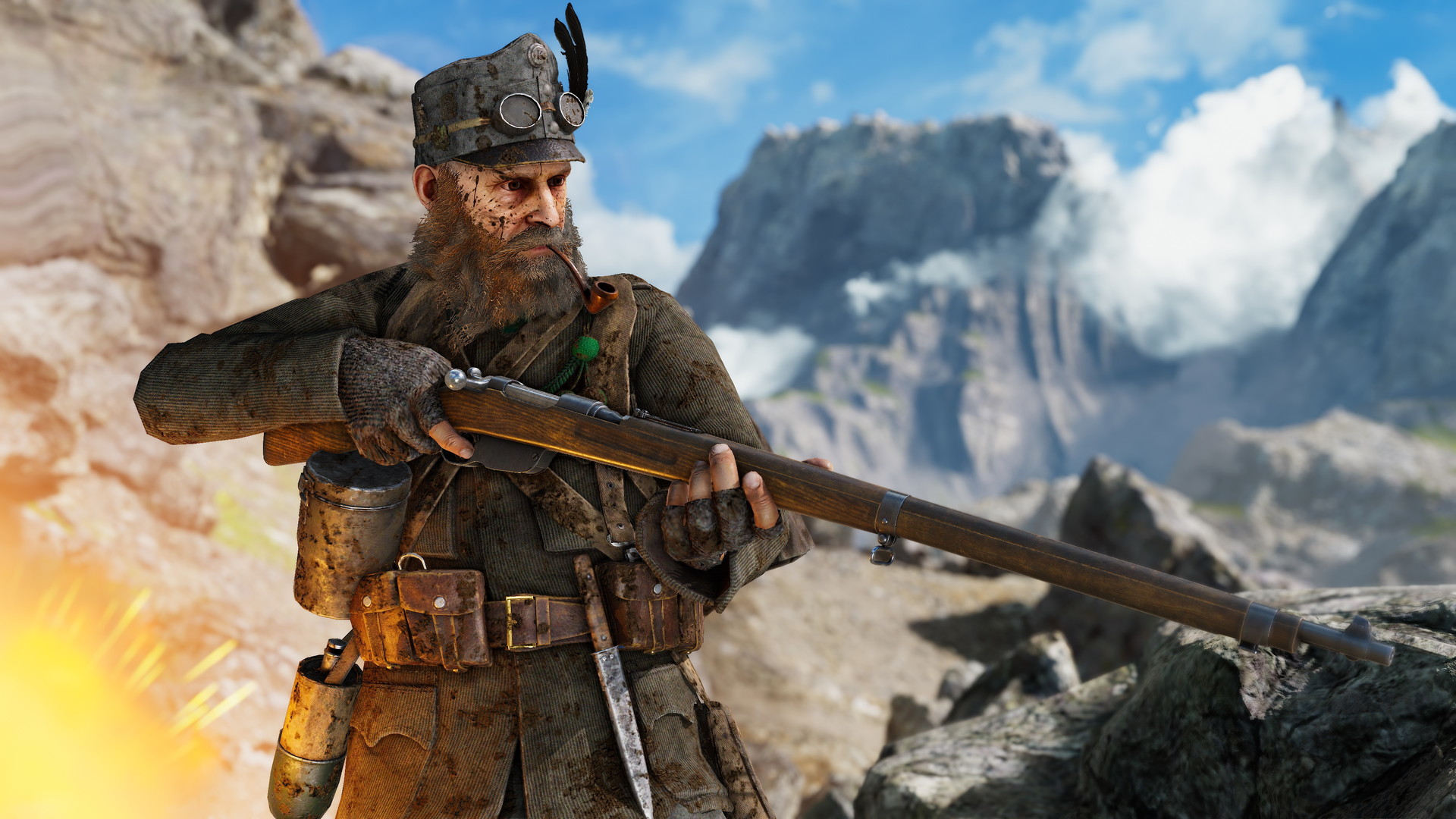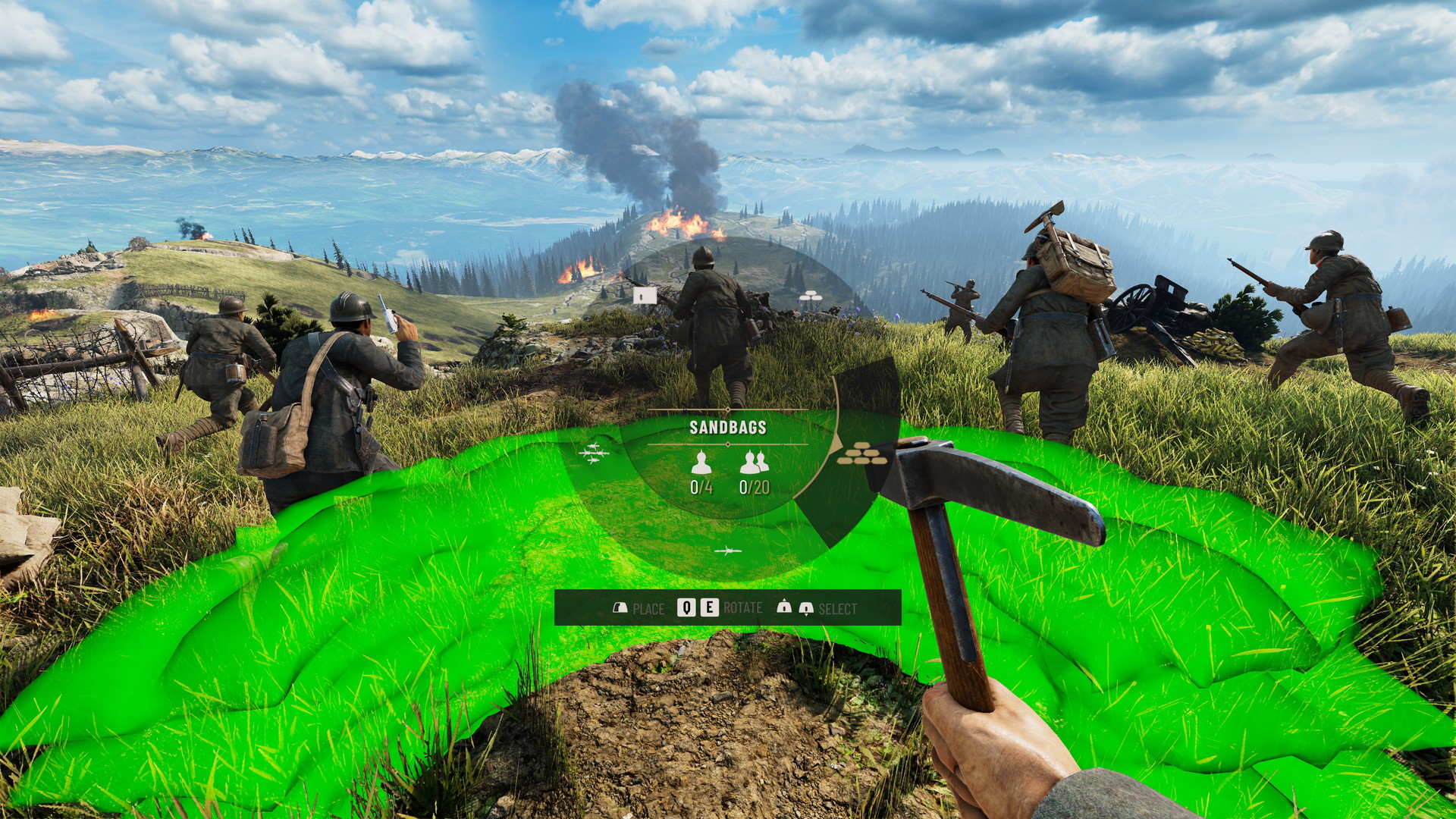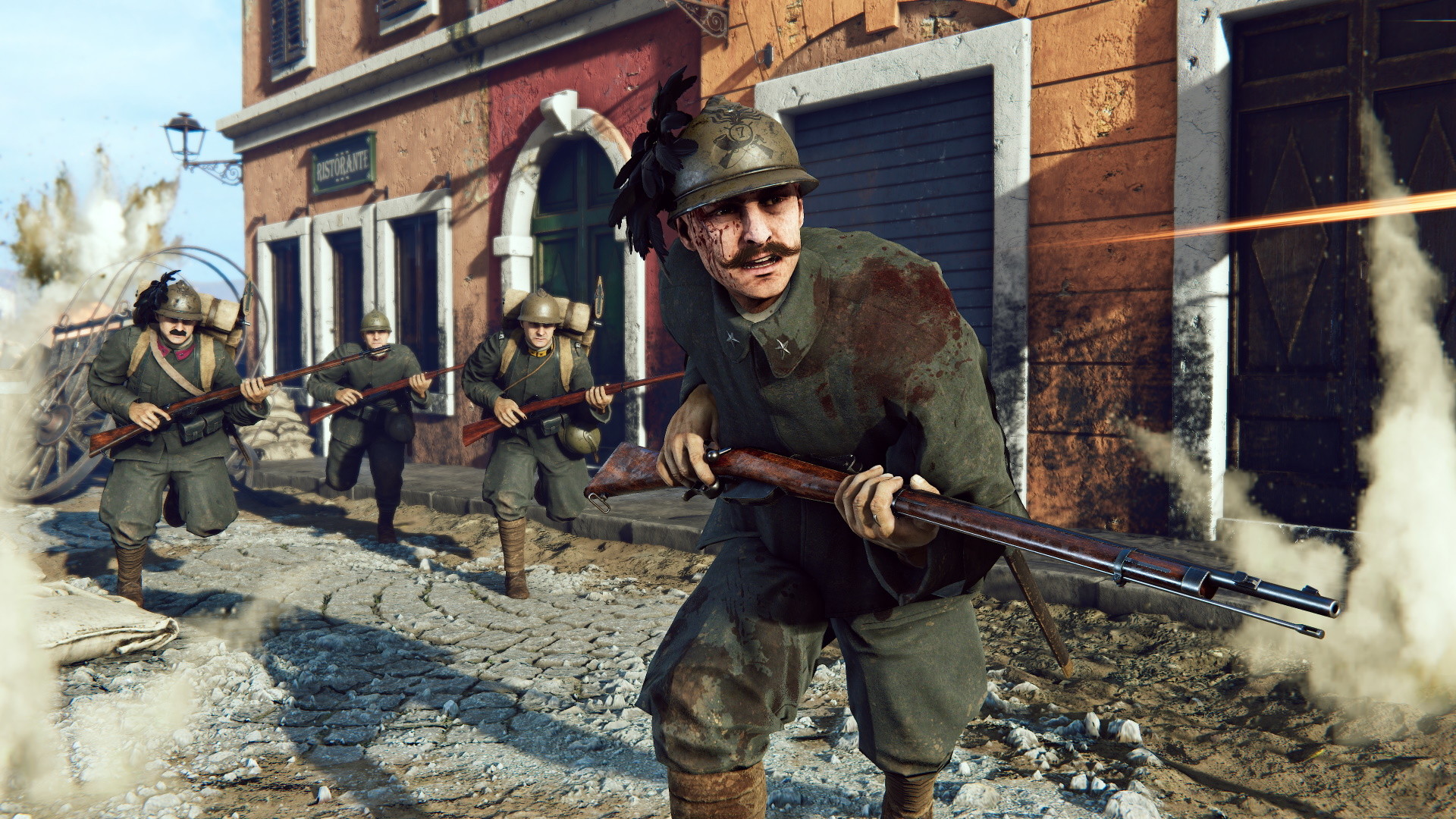World War One expands to the mountains of the Italian Front - beautiful but deadly in equal measure. Inspired by the two year struggle for control of the Isonzo river valley and the Alps during World War One, Isonzo elevates the WW1 Games Series, figuratively and literally.
From the makers of Verdun and Tannenberg …
The new Offensive game mode puts you right in the middle of key historical offensives on the Italian Front. Lead the charge across stunning Italian landscapes as you choose your path to victory - cut paths through barbed wire, flank your enemies by following mountain trails, or man a mortar to blast a way through. Shape a dynamic battlefield by laying sandbags and wire, placing ammo crates, deploying trench periscopes or sniper shields, and more.

Take part in historical offensives from the Sixth Battle of the Isonzo to the Strafexpedition. Reflecting the course of the actual battles, as the attackers advance the fighting will shift through vastly different landscapes within a single offensive: from hillside fortresses to mountain trenches and fierce urban combat on city streets. Everything is recreated based on research and field trips, from sound effects and uniforms down to the houses, vineyards and trenches you’ll be fighting over.
Call in support with a unique historically accurate flare system: flare guns can mark targets for artillery or biplane flybys, or different colored flares can be used to guide your team. Once the big guns have softened up the enemy, finish the job at close quarters with an Arditi dagger or mountaineer’s pickaxe. Man heavy machine guns, mortars and even mountain guns for more direct fire support.

Choose from six classes based on historical combat roles and build your loadout from a selection of weapons, equipment and perks linked to that class, giving flexibility and variety while staying grounded in what real soldiers might have carried. You’ll be operating wire cutters, bandaging yourself and wounded teammates, and blowing the whistle to start an assault. One shot can kill and even lighter injuries can lead to quickly bleeding out.
Being an effective soldier in Isonzo is not just about being a good marksman. Mastering the terrain is also key - the mountain can be a friend or foe. Learn how to navigate well to maintain cover and surprise your enemies or support your allies.
Finally… watch out for the dreaded poison gas. You’ve never experienced WW1 action quite like this!
Isonzo key features include:
More Games in the Authentic WW1 Game Series
Immerse yourself in more WW1 action with our other standalone titles Tannenberg and Verdun. Experience trench warfare on the Western Front in Verdun, or maneuver for control of key sectors in Tannenberg on the Eastern Front. These authentic WW1 shooters let players choose from a range of squads from across the war, as they fight for control of the ever-changing frontlines.
From the makers of Verdun and Tannenberg …
The new Offensive game mode puts you right in the middle of key historical offensives on the Italian Front. Lead the charge across stunning Italian landscapes as you choose your path to victory - cut paths through barbed wire, flank your enemies by following mountain trails, or man a mortar to blast a way through. Shape a dynamic battlefield by laying sandbags and wire, placing ammo crates, deploying trench periscopes or sniper shields, and more.

Take part in historical offensives from the Sixth Battle of the Isonzo to the Strafexpedition. Reflecting the course of the actual battles, as the attackers advance the fighting will shift through vastly different landscapes within a single offensive: from hillside fortresses to mountain trenches and fierce urban combat on city streets. Everything is recreated based on research and field trips, from sound effects and uniforms down to the houses, vineyards and trenches you’ll be fighting over.

Call in support with a unique historically accurate flare system: flare guns can mark targets for artillery or biplane flybys, or different colored flares can be used to guide your team. Once the big guns have softened up the enemy, finish the job at close quarters with an Arditi dagger or mountaineer’s pickaxe. Man heavy machine guns, mortars and even mountain guns for more direct fire support.

Choose from six classes based on historical combat roles and build your loadout from a selection of weapons, equipment and perks linked to that class, giving flexibility and variety while staying grounded in what real soldiers might have carried. You’ll be operating wire cutters, bandaging yourself and wounded teammates, and blowing the whistle to start an assault. One shot can kill and even lighter injuries can lead to quickly bleeding out.
Being an effective soldier in Isonzo is not just about being a good marksman. Mastering the terrain is also key - the mountain can be a friend or foe. Learn how to navigate well to maintain cover and surprise your enemies or support your allies.
Finally… watch out for the dreaded poison gas. You’ve never experienced WW1 action quite like this!
Isonzo key features include:
- Mountain warfare: Assaulting mountain fortifications, battling through ruined towns, and fording rivers are just a few of the challenges you’ll face as you fight your way through numerous enemy positions
- Tactical multiplayer FPS: Choose your role and loadout carefully to survive this high altitude combat - play a sniper to pick off the enemy engineers before they can cut your wire, use rifle grenades to clear enemy machine guns, and much more
- World War One Gameplay: Historical Offensive game mode based on real battles and focused on the unique challenges of Alpine warfare. Fight with 30+ WW1 weapons, poisonous gas attacks, and intense artillery barrages
- Build for victory: Place your own wire, sandbags, trench periscopes, and more! Whether you’re digging in or on the attack, shaping the battlefield to your advantage will be key to victory
- Faces of war: Make every class your own by picking from a variety of historically class-appropriate uniforms, accessories and headgear. As a finishing touch, you can even pick your mustache from several famous period-accurate styles!
- Authentic WW1 atmosphere: Accuracy in everything from maps and weaponry to music and the uniforms – fight for the Kingdom of Italy or the Austro-Hungarian Dual Monarchy

More Games in the Authentic WW1 Game Series
Immerse yourself in more WW1 action with our other standalone titles Tannenberg and Verdun. Experience trench warfare on the Western Front in Verdun, or maneuver for control of key sectors in Tannenberg on the Eastern Front. These authentic WW1 shooters let players choose from a range of squads from across the war, as they fight for control of the ever-changing frontlines.
Devblog #58 - Meet the Dev 04
In the previous devblog, weve asked you all to fill in our player survey. This is to make sure that were putting our development focus in the right areas, and to keep our fingers on the pulse of the WW1 Game Series community.
Many of you have already done so, thank you very much! This is a reminder for the people who mightve missed it (or forgot it). You can click here to be redirected to the survey.
Weve heard some of you struggling to fill in the survey due to the Google login requirements. This is a safety precaution. Well look into other alternatives for future surveys.
Now lets meet another programmer in our team!
Hello! Could you introduce yourself
Hi, my name is Nico, Im 39 years of age and I live in Utrecht, right in the middle of The Netherlands. I studied Computer Science at the University of Groningen and moved here to Utrecht in 2012 to work at a game company. After moving back and forth between different fields of software development for a few years, in late 2015 I decided to start a freelance career.
I was introduced to the WW1 team on literally the first day of being a freelancer, and worked with them on Verdun for a few months initially. I didnt become a full-fledged member of the team until the end of 2017 though, when Tannenberg was in development.
What is your role in BlackMill Games and for the games?
Officially, Im no longer a member of the BlackMill team! I left at the end of last year and rejoined on a consultancy basis to work on the FidelityFX Super Resolution 2.2 (FSR2) implementation and to help out in other areas that I have knowledge of.
Before that though, I was primarily responsible for the console ports of the WW1 games. This started with just technical work: integrating various console features, optimization work and producing builds. Over the years, Ive taken on more responsibilities including QA, release management and managing communications with Sony and Microsoft.
Where did your passion come from?
From playing games as a kid back in the 90s, as trite as it may sound. I was an impressionable child and anytime I saw someone make or do something cool, Id be like I wanna do that too!. Computers, games and programming are what stuck around long enough to become a career and I cant complain about it. If I had pursued a career in music, comic book drawing or operating drawbridges, I probably would have struggled a lot more in life.
Playing other peoples games and seeing how they were made is what made me passionate about creating games myself. Fortunately, I had a knack for programming and I learned a lot from modding existing games while still in middle school. Throughout my studies, I kept up-to-date with what was happening in graphics technology, worked on hobby game projects of my own, and tried to make choices with the idea of someday working in game development in mind. Im glad that that worked out in the end, even if it took me a while to get there.
What was the first thing you made in Isonzo?
The first thing I did for Isonzo was to make it run on the Xbox One console. This was shortly after the console release of Tannenberg in mid-2020, so the production of Isonzo was already well underway by then. It was not a pretty sight. The game ran at barely 10 fps on the Xbox One X and that was despite the maps still being very basic and missing a lot of the details that made it into the final release. A lot of work has been done to whip the game into shape since then.

What is a memorable moment in the development of Isonzo?
Very recently, the moment FSR 2.2 first started working in Isonzo and I could see the potential of what it would bring to the game. It felt like I was looking at an offline render, rather than something that was being drawn in real-time. Everything looked sharp with clean edges, distant objects were displayed with perfect clarity and details popped like never before. It was at that moment that I knew my gamble to work on this research project had paid off.

Of course, a still shot like this is a bit flattering and there were plenty of problems yet to solve once things started moving around, but this gave me the motivation to promote the feature to the team and to really push for its inclusion in the game. Fortunately, it was not too hard to convince them of its value and Im very happy with the way they supported me to get FSR2 across the finish line.
Another memorable moment is an older one, when I was first testing builds of Isonzo on PS5. That console is quite a bit different from the Windows and DirectX environments that were so used to, so it often has a lot of unique issues that crop up. Initially, all of the shaders were completely broken, causing all sorts of bogus pixel values to be drawn and together with bloom and other post-processing effects, it made the entire map light up like a Christmas tree. I affectionately called this glitch Disco Isonzo.

In general, I look back fondly at the last few months of development before release and witnessing the game gradually come together thanks to the hard work from everyone on the team. Getting Isonzo to run, look and play decently well on consoles felt like an impossible task at times and I would not have been able to do that on my own without everyone pulling together and making it work.
Can you show off some of your work process and tell us what youre doing?
A lot of my time is spent looking at code, which is not the most visually exciting thing to be showing off. Lately though, I have been doing a lot of performance analysis and bug fixing using GPU profilers, so I can show some of that.
Below is a GPU timing snapshot of a typical single frame on Xbox One S

When I first ran tests of FSR 2.2 on Xbox One, I was very sceptical whether it was going to be worth it. 6 milliseconds of GPU time to run FSR2 on a budget of 33 ms (to hit 30 fps), with nearly 8 ms spent on post-processing in total. No way would that ever be compensated by rendering the game at a lower resolution internally.
But I was wrong. In fact, the game ran considerably better with FSR2 enabled, even on the least capable consoles. On some maps, for example Fior, the frame rate jumped from the mid-20s to the low 40s while walking around in the forest. Not only that, using FSR2 also helped to smooth out the performance spikes in more graphically demanding areas. It was a true game changer!
Just a few weeks before we were going to launch FSR 2.2 on consoles, I received a report that players were able to see ghost images of each other through walls on PS5. It was pretty bad.

This was clearly an issue with motion vector rendering, and its something that had plagued us before, but we never figured out what caused it. I was mindful of this problem when I worked on FSR2 and specifically checked for it, but as it turns out, it only happens on PS5 and Xbox Series X|S and nowhere else.
Its crucial for FSR 2.2 that motion vectors are correct, so this time I had to really dig into this problem and find out why it was happening. A GPU capture confirmed that indeed, all was not well with the motion vectors:

The color buffer on the left is perfectly fine: the other player is obscured by the rock and not drawn, as you would expect. However, the motion vector buffer on the right clearly shows the other player. This causes FSR2s image reconstruction to think those pixels should be moving, and so it will make a ghost image appear on the rock.
It took me almost a full day and a lot of pouring through GPU data to finally figure out that Unity was for some reason adding an arbitrary offset to meshes when drawing motion vectors for moving objects, which drew them closer to the camera. In this case, close enough that the player model was considered to be in front of the rock and its motion vectors were drawn. Just a small change to the motion vector shader code fixed this and FSR2 was good to go again.
At the moment I am still working on further refining and improving our FSR 2.2 implementation. One often-heard complaint is that scopes have become blurry and smeary, making them hard to use. This is because the scopes zoomed-in view isnt a proper part of the main scene, and so FSR2 doesnt really know what to do with it. The correct solution for this problem isnt super obvious, so it took us a while to understand what we needed to do here.

What you want in this case is for the scope image to be composited into the scene, that is, for it to just get glued into the final picture without any further modifications. Fortunately for this, FSR2 has the ability to take a composition mask as an input, which tells it which pixels should be left alone. So, the challenge for us was to isolate the scope lens and draw it to a separate composition mask. The above image shows the result of that. Were also doing the same for water surfaces as those too are animated texture effects and require special treatment by FSR2.
Which other game dev/studio inspires you?
Historically, id Software has been a great source of inspiration for me. They were always at the forefront of PC gaming technology. Their Doom and Quake games allowed me to get a start in modding and game programming. Their generous open sourcing of their engines allowed millions of aspiring game developers, myself included, to learn and understand how games work under the hood. Without them, I dont think I would be working in game development today.
A bit closer to home, Ive always had a deep respect for Nixxes and the quality of the conversion work theyre doing. From all the way back in the Dreamcast days up until today, whenever Nixxes ports a game to another platform you know that a lot of care and attention will have been put into it. I look at their work as a reference for the quality I should be striving for.
Favourite game atm?
The last two years I have been captivated by Soulsborne games. I keep coming back to Dark Souls, Bloodborne and Dark Souls III. Last years Elden Ring was an amazing experience. Lies of P which comes out later this year is looking very promising too.
Whenever I want to hang out and chat with my friends, PUBG is still my game of choice. Paradoxically, despite being a rather hardcore and deeply unforgiving game, it offers a lot of quiet moments too where you can just chill and have fun together.
While everyone else is being hyped by the shiny new Final Fantasy XVI right now, Ive been intrigued by the Pixel Remasters of the classic Final Fantasy titles. Currently Im playing through Final Fantasy V for the first time and Im thoroughly enjoying it.
Finally, recently me and my friends discovered Placid Plastic Duck Simulator which is extremely silly, as youre literally doing nothing but watching rubber ducks bob around in a pool. However, it is strangely fascinating and Ive already spent way more hours on it than is sensible.
Anything else you want to share?
For anyone who may be dreaming of working in game development someday, the best I can say is: be proactive, be curious, and make things! Even if youre repeating what someone else has already done before you, the best way to learn is by doing and then showing other people what youre capable of. Never stop being curious.
Thank you everyone for reading and I hope you found it interesting to see some of what went on behind the scenes on the console side of Isonzo and what weve been doing lately to further improve the game.
Dont forget that the Film Memoir mode is available for free until August 4 for all our games. You can enable this by going to Settings -> Graphics. We hope you enjoy this special feature and create some fun & interesting footage.

Additionally, Verdun & Isonzo are currently both discounted.
https://store.steampowered.com/app/242860/Verdun/ https://store.steampowered.com/app/1556790/Isonzo/
Hello soldiers!
The devblog is arriving early this time! And besides meeting another member of the devteam, we have exciting news!

Yes thats right, Isonzo now has Steam Trading Cards & Point Shop Items! We know many of you have been asking for it, and were happy to finally share this with you. Time to Isonzo-fy your Steam profile!

Survey Reminder
In the previous devblog, weve asked you all to fill in our player survey. This is to make sure that were putting our development focus in the right areas, and to keep our fingers on the pulse of the WW1 Game Series community.
Many of you have already done so, thank you very much! This is a reminder for the people who mightve missed it (or forgot it). You can click here to be redirected to the survey.
Weve heard some of you struggling to fill in the survey due to the Google login requirements. This is a safety precaution. Well look into other alternatives for future surveys.
Now lets meet another programmer in our team!
Meet the Dev
Hello! Could you introduce yourself
Hi, my name is Nico, Im 39 years of age and I live in Utrecht, right in the middle of The Netherlands. I studied Computer Science at the University of Groningen and moved here to Utrecht in 2012 to work at a game company. After moving back and forth between different fields of software development for a few years, in late 2015 I decided to start a freelance career.
I was introduced to the WW1 team on literally the first day of being a freelancer, and worked with them on Verdun for a few months initially. I didnt become a full-fledged member of the team until the end of 2017 though, when Tannenberg was in development.
What is your role in BlackMill Games and for the games?
Officially, Im no longer a member of the BlackMill team! I left at the end of last year and rejoined on a consultancy basis to work on the FidelityFX Super Resolution 2.2 (FSR2) implementation and to help out in other areas that I have knowledge of.
Before that though, I was primarily responsible for the console ports of the WW1 games. This started with just technical work: integrating various console features, optimization work and producing builds. Over the years, Ive taken on more responsibilities including QA, release management and managing communications with Sony and Microsoft.
Where did your passion come from?
From playing games as a kid back in the 90s, as trite as it may sound. I was an impressionable child and anytime I saw someone make or do something cool, Id be like I wanna do that too!. Computers, games and programming are what stuck around long enough to become a career and I cant complain about it. If I had pursued a career in music, comic book drawing or operating drawbridges, I probably would have struggled a lot more in life.
Playing other peoples games and seeing how they were made is what made me passionate about creating games myself. Fortunately, I had a knack for programming and I learned a lot from modding existing games while still in middle school. Throughout my studies, I kept up-to-date with what was happening in graphics technology, worked on hobby game projects of my own, and tried to make choices with the idea of someday working in game development in mind. Im glad that that worked out in the end, even if it took me a while to get there.
What was the first thing you made in Isonzo?
The first thing I did for Isonzo was to make it run on the Xbox One console. This was shortly after the console release of Tannenberg in mid-2020, so the production of Isonzo was already well underway by then. It was not a pretty sight. The game ran at barely 10 fps on the Xbox One X and that was despite the maps still being very basic and missing a lot of the details that made it into the final release. A lot of work has been done to whip the game into shape since then.

What is a memorable moment in the development of Isonzo?
Very recently, the moment FSR 2.2 first started working in Isonzo and I could see the potential of what it would bring to the game. It felt like I was looking at an offline render, rather than something that was being drawn in real-time. Everything looked sharp with clean edges, distant objects were displayed with perfect clarity and details popped like never before. It was at that moment that I knew my gamble to work on this research project had paid off.

Of course, a still shot like this is a bit flattering and there were plenty of problems yet to solve once things started moving around, but this gave me the motivation to promote the feature to the team and to really push for its inclusion in the game. Fortunately, it was not too hard to convince them of its value and Im very happy with the way they supported me to get FSR2 across the finish line.
Another memorable moment is an older one, when I was first testing builds of Isonzo on PS5. That console is quite a bit different from the Windows and DirectX environments that were so used to, so it often has a lot of unique issues that crop up. Initially, all of the shaders were completely broken, causing all sorts of bogus pixel values to be drawn and together with bloom and other post-processing effects, it made the entire map light up like a Christmas tree. I affectionately called this glitch Disco Isonzo.

In general, I look back fondly at the last few months of development before release and witnessing the game gradually come together thanks to the hard work from everyone on the team. Getting Isonzo to run, look and play decently well on consoles felt like an impossible task at times and I would not have been able to do that on my own without everyone pulling together and making it work.
Can you show off some of your work process and tell us what youre doing?
A lot of my time is spent looking at code, which is not the most visually exciting thing to be showing off. Lately though, I have been doing a lot of performance analysis and bug fixing using GPU profilers, so I can show some of that.
Below is a GPU timing snapshot of a typical single frame on Xbox One S

When I first ran tests of FSR 2.2 on Xbox One, I was very sceptical whether it was going to be worth it. 6 milliseconds of GPU time to run FSR2 on a budget of 33 ms (to hit 30 fps), with nearly 8 ms spent on post-processing in total. No way would that ever be compensated by rendering the game at a lower resolution internally.
But I was wrong. In fact, the game ran considerably better with FSR2 enabled, even on the least capable consoles. On some maps, for example Fior, the frame rate jumped from the mid-20s to the low 40s while walking around in the forest. Not only that, using FSR2 also helped to smooth out the performance spikes in more graphically demanding areas. It was a true game changer!
Just a few weeks before we were going to launch FSR 2.2 on consoles, I received a report that players were able to see ghost images of each other through walls on PS5. It was pretty bad.

This was clearly an issue with motion vector rendering, and its something that had plagued us before, but we never figured out what caused it. I was mindful of this problem when I worked on FSR2 and specifically checked for it, but as it turns out, it only happens on PS5 and Xbox Series X|S and nowhere else.
Its crucial for FSR 2.2 that motion vectors are correct, so this time I had to really dig into this problem and find out why it was happening. A GPU capture confirmed that indeed, all was not well with the motion vectors:

The color buffer on the left is perfectly fine: the other player is obscured by the rock and not drawn, as you would expect. However, the motion vector buffer on the right clearly shows the other player. This causes FSR2s image reconstruction to think those pixels should be moving, and so it will make a ghost image appear on the rock.
It took me almost a full day and a lot of pouring through GPU data to finally figure out that Unity was for some reason adding an arbitrary offset to meshes when drawing motion vectors for moving objects, which drew them closer to the camera. In this case, close enough that the player model was considered to be in front of the rock and its motion vectors were drawn. Just a small change to the motion vector shader code fixed this and FSR2 was good to go again.
At the moment I am still working on further refining and improving our FSR 2.2 implementation. One often-heard complaint is that scopes have become blurry and smeary, making them hard to use. This is because the scopes zoomed-in view isnt a proper part of the main scene, and so FSR2 doesnt really know what to do with it. The correct solution for this problem isnt super obvious, so it took us a while to understand what we needed to do here.

What you want in this case is for the scope image to be composited into the scene, that is, for it to just get glued into the final picture without any further modifications. Fortunately for this, FSR2 has the ability to take a composition mask as an input, which tells it which pixels should be left alone. So, the challenge for us was to isolate the scope lens and draw it to a separate composition mask. The above image shows the result of that. Were also doing the same for water surfaces as those too are animated texture effects and require special treatment by FSR2.
Which other game dev/studio inspires you?
Historically, id Software has been a great source of inspiration for me. They were always at the forefront of PC gaming technology. Their Doom and Quake games allowed me to get a start in modding and game programming. Their generous open sourcing of their engines allowed millions of aspiring game developers, myself included, to learn and understand how games work under the hood. Without them, I dont think I would be working in game development today.
A bit closer to home, Ive always had a deep respect for Nixxes and the quality of the conversion work theyre doing. From all the way back in the Dreamcast days up until today, whenever Nixxes ports a game to another platform you know that a lot of care and attention will have been put into it. I look at their work as a reference for the quality I should be striving for.
Favourite game atm?
The last two years I have been captivated by Soulsborne games. I keep coming back to Dark Souls, Bloodborne and Dark Souls III. Last years Elden Ring was an amazing experience. Lies of P which comes out later this year is looking very promising too.
Whenever I want to hang out and chat with my friends, PUBG is still my game of choice. Paradoxically, despite being a rather hardcore and deeply unforgiving game, it offers a lot of quiet moments too where you can just chill and have fun together.
While everyone else is being hyped by the shiny new Final Fantasy XVI right now, Ive been intrigued by the Pixel Remasters of the classic Final Fantasy titles. Currently Im playing through Final Fantasy V for the first time and Im thoroughly enjoying it.
Finally, recently me and my friends discovered Placid Plastic Duck Simulator which is extremely silly, as youre literally doing nothing but watching rubber ducks bob around in a pool. However, it is strangely fascinating and Ive already spent way more hours on it than is sensible.
Anything else you want to share?
For anyone who may be dreaming of working in game development someday, the best I can say is: be proactive, be curious, and make things! Even if youre repeating what someone else has already done before you, the best way to learn is by doing and then showing other people what youre capable of. Never stop being curious.
Thank you everyone for reading and I hope you found it interesting to see some of what went on behind the scenes on the console side of Isonzo and what weve been doing lately to further improve the game.
Film Memoir
Dont forget that the Film Memoir mode is available for free until August 4 for all our games. You can enable this by going to Settings -> Graphics. We hope you enjoy this special feature and create some fun & interesting footage.

Additionally, Verdun & Isonzo are currently both discounted.
https://store.steampowered.com/app/242860/Verdun/ https://store.steampowered.com/app/1556790/Isonzo/
See you next time soldiers o7
[ 2023-08-01 14:07:56 CET ] [Original Post]
Minimum Setup
- OS: Requires a 64-bit processor and operating system
- Processor: Intel Core 2 Quad Q9550Memory: 4 GB RAM
- Memory: 4 GB RAM
- Graphics: NVIDIA GeForce GT 640
- Storage: 20 GB available space
Recommended Setup
- OS: Requires a 64-bit processor and operating system
- Processor: Intel i7-4770Memory: 16 GB RAM
- Graphics: NVIDIA GeForce GTX 1050
- Storage: 20 GB available space
GAMEBILLET
[ 6444 ]
GAMERSGATE
[ 2268 ]
MacGamestore
[ 1913 ]
FANATICAL BUNDLES
HUMBLE BUNDLES
by buying games/dlcs from affiliate links you are supporting tuxDB

